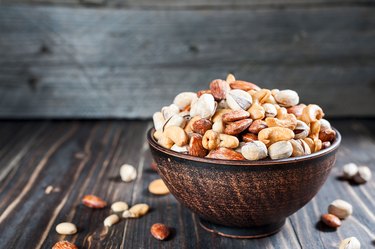
Nuts (and their cute little cousins, seeds) are a popular snack food. Whether picked on at parties, eaten out of bags at baseball games or toted to work as an afternoon pick-me-up, nuts — in their array of types and tastes — have won many loyal fans.
A good thing, as both nuts and seeds are packed with nutrients. That said, many people struggle with sticking to a serving size. They're so yummy and crunchy (salty, too) that it can be hard to stop eating them once you start. But given how calorie dense they are, an unbridled nut habit can be a hindrance to maintaining a healthy weight. Before you go nuts, it pays to be mindful of what a smart serving of nuts or seeds actually is.
Video of the Day
Video of the Day
A Serving Size of Nuts
We often hear that "a handful" is one serving of nuts. But, obviously, that leaves much room for interpretation. While limiting yourself to a handful is more helpful than just eating them directly out of the bag, it's even better to narrow that definition of a serving. According to the United States Department of AgricultureAgricultural Research Service (USDA), a proper serving is one ounce, which is roughly equal to 1/4 cup. This corresponds to the serving size listed on many packages of nuts and seeds. Knowing the number of nuts that typically makes up a one-ounce serving can make it easier to properly portion them out: Approximately 14 walnut halves, 24 almonds, 16 cashews, 28 peanuts and 45 pistachios equal one serving.
That one-ounce serving of nuts turns up with about 160 to 200 calories, at least 80 percent of which is from fat, according to the Cleveland Clinic. It's primarily monounsaturated, which when swapped in for saturated fat in the diet, can help reduce LDL — or "bad" — cholesterol levels while maintaining the "good" cholesterol, HDL.
Read more: 9 Healthy Nuts That May Help You Live Longer
A Serving Size of Seeds
Seeds are also nutrient-rich, smart snack choices. The serving size for seeds, like nuts, is one ounce, which will net you 12 grams of polyunsaturated fat and around 150 calories. Seeds can be harder to count out by number than nuts. Holly Larson, MS, RD, and Director of Nutrition at Brain Balance Achievement Centers in Oxford, Ohio has a trick: "Measure out ¼ cup of your favorite seeds and then pour that amount into your hands. Now you know what one serving looks like for you."
Pumpkin (otherwise known as pepitas), sesame and sunflower seeds are popular picks, but other tasty seeds worth a try are flaxseed, hemp and chia.
The Health Perks
Despite their potential to fatten us up if eaten indiscriminately, seeds and nuts boast an impressive health profile. Aside from the "good" fats that help reduce "bad" cholesterol levels, nuts and seeds include impressive amounts of vitamins E and B, as well as zinc, selenium and certain amino acids. Nuts and seeds are also considered excellent sources of disease fighting antioxidants. But sweet-toothed consumer, beware! Candy-coated nuts — like Jordan almonds — don't count! Unsalted, dry-roasted or raw nuts and seeds are the healthiest choice.
Also: As much as peanut butter and other nut butters have their place in a healthy diet, many brands are high in sugar and so should be savored sparingly. Ideally, less is more. "The ingredients list should only be two ingredients: The nut or seed and salt, nothing else," says Larson.
Read more: 13 Powerful Grains and Seeds
Which Kind of Nut or Seed Is Best?
"A variety is best!" emphasizes Larson. "Each nut or seed has a different nutrient profile," she explains. "A single Brazil nut has the full amount of selenium — a powerful antioxidant — for the day. Pumpkin seeds are rich in copper and zinc, while walnuts are especially rich in manganese." The bottom line: Mix it up over the course of the week.
The Best Ways to Eat Nuts and Seeds
Nuts and seeds are perfect for beating between-meal munchies, as they will keep you full longer than carb-based snacks. "They're portable, they won't get bruised or damaged while bouncing around in your backpack or purse, and they won't spoil for a long time," says Larson.
But there are many other simple ways to include them in a balanced diet. Cashews and peanuts are delish in a stir-fry; slivered almonds and larger seeds are both a far better salad topping than bacon bits or croutons. Fine seeds, like chia, make a great yogurt garnish.
Want to get creative? Larson shares these go-to ideas. "Mix two cups of nuts or seeds with one of these seasoning blends. A bonus is that spices offer an additional anti-inflammatory boost."
- Mediterranean: Two tablespoons of olive oil, one teaspoon dried rosemary, ½ teaspoon dried garlic, salt and pepper to taste
- TexMex: Two tablespoons of olive oil, one teaspoon chili powder, ½ teaspoon smoked paprika, salt and pepper to taste
- Indian: Two tablespoons of olive oil, one teaspoon turmeric, one teaspoon curry powder, ½ teaspoon cayenne pepper, salt and pepper to taste